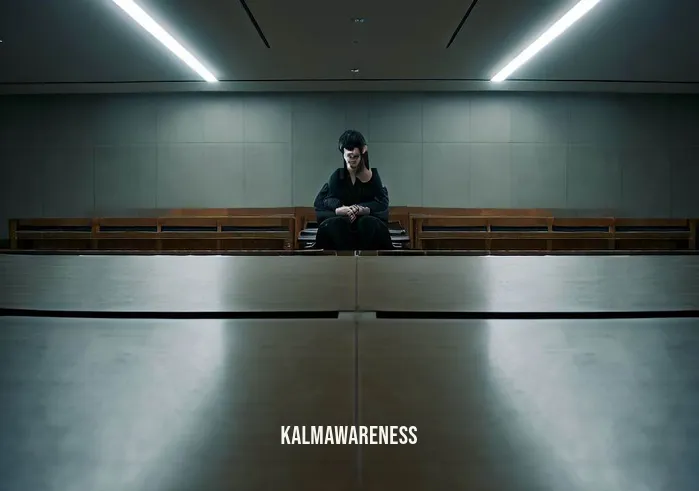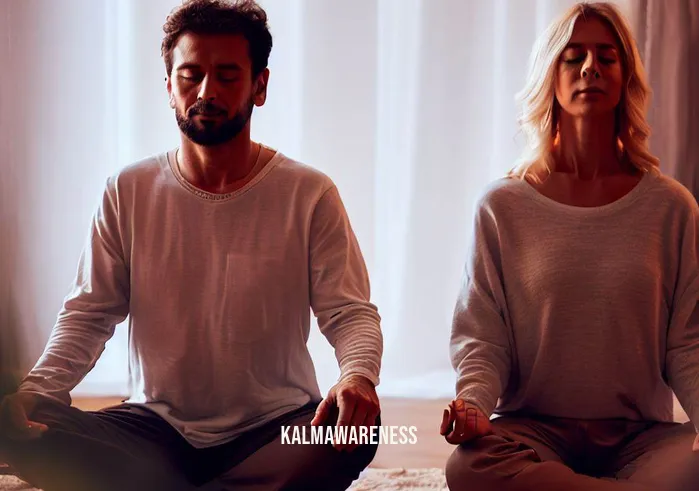Divorce Meditation: The Beginning of a Healing Journey
The Emotional Turmoil of Divorce
Divorce is a monumental life change that often brings a cascade of emotional upheaval. Whether the decision to part ways is mutual or one-sided, the emotional distress that ensues can be all-encompassing. The feelings of loss, anger, confusion, and even betrayal can weigh heavily on one’s emotional well-being. The question then arises: How can we navigate through this challenging life event and find peace? The answer might be closer than you think — in the practice of divorce meditation.
The Intersection of Mindfulness and Emotions
To understand the utility of divorce meditation, one must first grasp the concept of anger mindfulness. Anger is a common emotion experienced during and after divorce. The intensity of this emotion can sometimes cloud our judgment, making it difficult to think clearly or make rational decisions. Mindfulness techniques can help individuals gain control over their emotions, rather than being ruled by them.
“The ultimate measure of a person is not where they stand in moments of comfort, but where they stand at times of challenge and controversy.” — Martin Luther King, Jr.
Beyond Anger: Emotional States Explored
It’s essential to note that anger isn’t the only emotion one feels during a divorce. Sadness, guilt, and even relationship anxiety are common companions. We must treat each of these emotional states with the compassion and awareness they deserve.
For instance, it is quite normal to experience a sense of loss or loneliness. Here, a technique like guided meditation for joy can be particularly beneficial. Such meditation practices focus on the happier aspects of life and encourage individuals to find joy even in the simplest of things.
Self-Compassion: The Cornerstone of Healing
One of the key elements to successfully navigating through divorce is the practice of self-compassion. Our emotional states are closely linked to how we perceive and treat ourselves. The practice of self-compassion journal prompts can be extremely useful in this journey towards self-acceptance and healing.
- Acknowledge Emotions: The first step in self-compassion is acknowledging your emotions without judgment.
- Understand Your Needs: Often we are harsher with ourselves than we are with others. Understanding your needs is crucial in treating yourself with kindness.
- Forgive and Move On: Holding onto past mistakes and regrets only hampers your healing process.
Bridging Meditation and Emotional Well-being
The importance of maintaining emotional well-being cannot be stressed enough, particularly during stressful times like a divorce. Meditation practices designed for emotional regulation, such as Spiritfarer meditation and calm heart meditation, act as potent tools for attaining emotional balance. These meditations provide a structured way to delve into your emotions, understand them, and finally, find a way to balance them.
To sum it up, divorce meditation can serve as an empowering avenue towards healing and emotional stability. The integration of various mindfulness techniques can serve as your emotional toolkit for coping with divorce’s complexities. Although the journey may seem daunting, remember that emotional well-being is achievable, and you are not alone.
For those interested in diving deeper into advanced techniques and understanding the transformative power of meditation, continue reading to explore the spiritual dimensions of healing, including how chakra for happiness can add a unique layer to your emotional recovery.

The Healing Alchemy of Divorce Meditation
Transforming Pain into Self-Discovery
We touched on the importance of self-compassion and mindfulness in mitigating the emotional toll of divorce. Now, let’s delve into the profound healing capabilities of divorce meditation. The transformation from marital distress to personal growth can be likened to alchemy—the ancient process of turning base metals into gold. Through practices like deep compassion and binaural beats for depression, one can channel the emotional energy from the divorce into a journey toward self-discovery and healing.
Alleviating Mental Load with Divorce Meditation
Handling the logistical and emotional aspects of a divorce can be mentally taxing. The concept of task-shifting for mental health helps us understand how meditation can effectively alleviate some of this mental load. By compartmentalizing tasks and concerns, we free up mental space to focus on healing and emotional well-being.
The Different Flavors of Divorce Meditation
The practice of meditation isn’t monolithic; it comes in various forms and flavors, each with its unique set of benefits tailored to different emotional needs.
Table: Types of Divorce Meditations and Their Benefits
| Type of Meditation | Emotional Benefit | Example Technique |
|---|---|---|
| Breakup Meditation | Emotional Release | Guided Imagery |
| Dalai Lama Anxiety Meditation | Anxiety Reduction | Mindfulness Breathing |
| Brene Brown Toxic Positivity Meditation | Reality Acceptance | Thought Awareness |
| Spiritual Meaning of Lower Back Pain Meditation | Physical and Emotional Healing | Chakra Balancing |
| Andrew Huberman Gratitude Meditation | Positive Mindset | Gratitude Journaling |
Elements to Incorporate in Your Divorce Meditation Practice
- Emotional Acknowledgment: Recognize the legitimacy of your feelings without trying to suppress or alter them.
- Mindful Breathing: Integrate focused breathing to become fully aware of your present state.
- Visual Prompts: Utilize peaceful imagery to direct your mind away from emotional turmoil.
- Affirmations: Use positive affirmations to build self-worth and to reinforce positive self-image.
- Guidance: If self-led meditation seems challenging, consider using guided sessions like Brene Brown Meditation to help steer your practice.
Beyond the Bounds of Traditional Healing
While traditional therapeutic interventions may offer some relief, divorce meditation provides an avenue for deeper self-exploration and emotional balance. Whether you are struggling with feeling blue or searching for a meaning beyond happiness, divorce meditation has a layered approach to aid in your healing journey.
“It is only in our darkest hours that we may discover the true strength of the brilliant light within ourselves that can never, ever, be dimmed.” — Doe Zantamata
By treating the emotional, psychological, and even the physical facets of your well-being, divorce meditation stands as a comprehensive remedy for the intricate emotional labyrinth of a broken marriage.
What Awaits You Ahead
As we’ve seen, divorce meditation isn’t just a coping mechanism—it’s a transformative practice. In the next chapter, we will explore how to practically integrate these techniques into your daily routine. You’ll discover how to set attainable goals, measure your progress, and adapt your strategies for long-lasting emotional resilience. Continue reading to unravel how you can master your emotional well-being through the art of divorce meditation.

The Beacon of Hope in Divorce Meditation
The Silver Lining: Unearth Hope Through Meditative Practices
Divorce is a life event often saturated with varying shades of pain and disappointment. However, it can also serve as a crossroads, a place where you can either continue to be mired in your sorrows or choose a transformative path. This is where the powerful practice of divorce meditation, or as some may call it, “marital separation mindfulness,” can serve as a beacon, guiding you towards rediscovering hope and meaning.
“Hope is being able to see that there is light despite all of the darkness.” — Desmond Tutu
The Role of Inspirational Figures
Divorce meditation is not merely a self-improvement tool; it is a holistic approach that integrates well-established mindfulness techniques and the wisdom of luminaries in the field. For example, you might be inspired by the work of Brene Brown on toxic positivity, which can aid in combating the societal pressure to “move on” swiftly and superficially. Her ideas could provide you with the framework to incorporate more authentic, transformative changes into your meditation routine.
Harnessing the Power of Gratitude
“Gratitude makes sense of our past, brings peace for today, and creates a vision for tomorrow.” — Melody Beattie
While divorce can be painful, this period also offers an opportunity for reflection. In the words of Andrew Huberman on gratitude, you can harness the energy of thankfulness to foster a healthier mindset. Whether it’s being thankful for newfound independence or opportunities for self-discovery, gratitude can be a transformative element in your divorce meditation practices.
Realigning Energies: A Spiritual Facet
Divorce often feels like your world has turned upside down, shaking your emotional and even your physical well-being. The spiritual meaning of lower back pain suggests that emotional turmoil can manifest in physical symptoms. In this context, your meditation practices could include chakra balancing or guided visualizations to restore physical and emotional harmony.
“Healing takes courage, and we all have courage, even if we have to dig a little to find it.” — Tori Amos
The Harmonic Symphony of Mind and Heart
Combining techniques like chakra for happiness and calm heart meditation can cultivate a sense of equilibrium between your mental and emotional states. This harmonization is crucial as you navigate the complexities of divorce and work toward establishing a new sense of normality.
Practical Tips for Staying Inspired
- Curate Your Space: Ensure your meditation area is free from distractions and is conducive to focusing on your practice.
- Join Online Communities: Find groups that focus on divorce meditation to stay motivated and to gain new insights.
- Book of Quotes: Keep a personal book of inspirational quotes and refer to it before or after your meditation sessions.
- Follow Luminaries: Keep up with the latest publications, talks, or interviews by thought leaders in mindfulness and divorce recovery.
What’s Coming Up Next
We’ve delved deep into the wellspring of hope and inspiration that divorce meditation can provide. As we’ve seen, this practice is a multi-dimensional approach that encompasses the emotional, intellectual, and even the spiritual facets of healing. However, sustaining these positive changes over the long term is where the real challenge lies.
In the next chapter, we will focus on making these practices a consistent part of your life, looking at how to create a sustainable routine, and ensure that the benefits of your divorce meditation experience continue to foster hope and inspiration in your post-divorce life. Continue reading to solidify your path towards complete emotional wellness.

The Anatomy of Divorce Meditation: A Comprehensive Guide
Why Divorce Meditation Matters
After exploring the hope and inspiration that divorce meditation can bring into your life, you might be asking, “How does this work at a granular level?” Divorce meditation—or as some might refer to it, “conscious uncoupling meditation”—serves multiple functions. It acts as an emotional salve, a cognitive reset, and a spiritual alignment tool.
The Multifaceted Benefits: A Bullet Point Breakdown
To get the full understanding of why divorce meditation is essential, let’s break it down into its numerous benefits:
- Emotional Stability: Helps you to keep your emotions in check, thereby preventing erratic behavior and impulsive decisions.
- Mental Clarity: Assists in clearing the fog of confusion that often surrounds the emotional upheaval of divorce.
- Inner Peace: Provides a sense of serenity, essential for making well-thought-out decisions.
- Spiritual Grounding: Can offer an avenue for deeper self-reflection and connection with your inner self.
- Physical Well-being: As seen in practices like Spiritfarer Meditation, there’s a tangible impact on your physical wellness.
- Stress Reduction: Lowers the stress hormones in your body, offering a medical benefit in addition to emotional and mental ones.
Types of Divorce Meditation: A Handy List
Understanding that there are various approaches can help you tailor your practice for maximum effectiveness. Here are some types to consider:
- Mindfulness Meditation: Focuses on being present and fully engaging with the here and now.
- Transcendental Meditation: Aims for reaching a unique state of restful alertness.
- Guided Meditation: You are guided by a narrator or guide, which is particularly effective for those new to meditation. Consider exploring a guided meditation for joy as a start.
- Binaural Beats Meditation: Uses sound frequencies for altering your state of mind. Binaural beats for depression can be especially effective during trying times.
- Body Scan Meditation: A form of mindfulness focusing on different body parts, effective for identifying and releasing tension.
A Word on Emotional Traps
While meditation provides various benefits, there are emotional pitfalls you may encounter during your journey.
- Suppressed Anger: Failing to deal with anger could result in it surfacing later in harmful ways. Learning about anger mindfulness can be incredibly helpful.
- Overthinking: Meditation is not a venue for rumination. Practices focused on task shifting for mental health can help to avoid the trap of overthinking.
“Understanding is the first step to acceptance, and only with acceptance can there be recovery.” — J.K. Rowling
Essential Practices and Resources
- Self-Compassion: As you navigate this process, remember to be kind to yourself. A series of self-compassion journal prompts can help keep you aligned.
- Regular Check-ins: Take time each week to evaluate your progress, emotional state, and any new issues that have arisen.
- Expert Advice: Sometimes, it helps to get advice from professionals. Many experts can guide you through the intricacies of divorce meditation.
A Glimpse into the Final Chapter
So far, we’ve looked at the practical aspects and emotional nuances of divorce meditation, but we’ve yet to explore how to ensure that this becomes a sustainable practice in your life.
The final chapter will focus on turning all these insights into a personalized divorce meditation regimen, a roadmap designed to serve you long-term. Continue reading to put the final pieces of your holistic healing journey in place.

Final Reflections: The Transformative Power of Divorce Meditation
The Journey We’ve Embarked On
We’ve navigated the complex yet incredibly enriching landscape of divorce meditation. Also known as emotional recalibration post-separation, it’s been a profound experience delving into how this practice can revolutionize our emotional well-being, especially during such a transformative phase in life. We’ve explored the mechanics, the types, and the emotional dynamics that divorce meditation can bring into play.
The Palette of Emotions
From achieving emotional stability to dealing with suppressed anger, we’ve covered a broad spectrum of emotional experiences. Divorce can often lead us down the path of relationship anxiety, yet meditation offers a lifeline for rediscovering tranquility and self-assurance.
“Sometimes the bad things that happen in our lives put us directly on the path to the best things that will ever happen to us.” – Nicole Reed
Light-Hearted Insights for a New Beginning
The adage “when one door closes, another opens” rings exceptionally true here. Divorce is undoubtedly an end but also a beginning—a fresh start that offers you a blank canvas to reimagine your life.
As the Dalai Lama has often suggested for overcoming anxiety, it’s essential to view challenges as opportunities for growth. So let’s adopt a mindset of positive realism, not to be confused with toxic positivity, as we transition to the next chapter of our lives.
A Nod to Inner Strength and Resilience
It’s been a compelling journey, hasn’t it? Yet the most striking discovery is recognizing our own resilience. Like the Buddhist teachings on deep compassion, divorce meditation leads us to deeper self-understanding and empathy—not just for others, but also for ourselves.
The Road Ahead: Your Call-to-Action
So where do we go from here? You’ve gained the knowledge and tools, but remember that wisdom lies in their application. If you still have lingering concerns or would like to explore related topics, feel free to revisit previous chapters or check out additional articles on the website.
We’d particularly recommend diving deeper into topics like healing through gratitude or even seeking happiness beyond the conventional understanding.
A Heartfelt Thank You
We want to thank you, dear reader, for embarking on this journey with us. Your commitment to personal growth and emotional well-being is an inspiration. We promise to continue delivering content that enriches, informs, and empowers you. From strategies for maintaining a calm heart to exploring the spiritual meaning of lower back pain, we’ve got an extensive range of topics lined up for future editions.
As you go forward, may you find the peace you seek, may your heart be light, and may your spirit be unburdened. The journey of a thousand miles begins with a single step, and you’ve already taken several. Here’s to many more!
“The only way to make sense out of change is to plunge into it, move with it, and join the dance.” – Alan Watts





